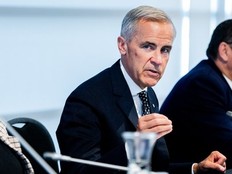GOLDSTEIN: Liberals’ clean energy crusade has been a super disaster
The U.S. has cut emissions at almost double Canada's rate, without imposing a national carbon tax

Article content
Before Prime Minister Mark Carney attempts to turn Canada into a clean energy superpower he needs to explain why a decade of Liberal government policies intended to achieve this have been a massive failure on every front.
According to the Liberal government’s own estimate, as of April 2023 it had spent or committed over $200 billion of taxpayers’ money to 149 government programs addressing climate change.
In terms of the primary goal of this spending, reducing Canada’s industrial greenhouse gas emissions to at least 40% below 2005 levels by 2030, the latest available government data from 2023 shows emissions were just 8.5% below 2005 levels.
Achieving the Liberals’ 2030 target will require the equivalent of eliminating all annual emissions from Canada’s transportation and building sectors in seven years, which would inevitably cause a massive recession.
When environmental commissioner Jerry V. DeMarco audited 20 of the government’s 149 programs, he found fewer than half were on track to achieve their goals and of 32 additional measures the government claimed would assist in reaching the 2030 target, only seven were new.
His audit uncovered examples where two different government programs were funding the same projects and reporting the same expected emission cuts, raising the possibility of double counting.
DeMarco said the government’s lack of transparency in reporting emissions made it impossible for the average citizen to understand its claims.
The computer modelling used to estimate emissions was also out of date and “recent decreases to projected 2030 emissions were not due to climate action taken by governments, but were instead because of revisions to the data used in modelling.”
DeMarco noted that aside from falling far short of its emission targets, Canada has the worst record of reducing emissions of any member of the G7, including the U.S.
The U.S. has cut emissions at almost double Canada’s rate, without imposing a national carbon tax.
In terms of getting value for money, auditor general Karen Hogan reported last year that in one of the government’s 149 climate programs – the now-disbanded $1-billion Sustainable Development Technology Fund – there were 90 cases where conflict-of-interest rules were ignored in awarding $76 million worth of government contracts and 10 cases where $56 million was awarded to ineligible projects.
DeMarco reported last week that despite spending over $6.6 billion on government programs to help Canadians adapt to more severe weather caused by climate change since 2015, the Liberals’ national adaptation strategy, released in 2023, lacked essential elements to make it effective and progress since then has been slow.
RECOMMENDED VIDEO
Parliamentary budget officer Yves Giroux last year estimated the cost of government subsidies to Canada’s auto sector to manufacture electric vehicles and batteries at up to $52.5 billion on 13 major projects – $31.4 billion, or 60%, paid by federal taxpayers and $21.1 billion, or 40%, paid by provincial taxpayers in Ontario and Quebec.
That’s $6.3 billion more than the announced investments of $46.1 billion the auto sector is contributing to these projects, with many now delayed due to slower than anticipated EV sales.
While Canada’s employment rate and economic growth are influenced by many factors, the Liberals have repeatedly promised since coming to power in 2015 that government spending on their climate policies would lead to significant increases in jobs and economic growth, which has not been the case.
Statistics Canada reported earlier this month that Canada’s unemployment rate rose to 7% in May, the highest it’s been since September 2016, excluding the 2020 and 2021 pandemic years, and a 12.9% increase from 6.2% a year ago in May.
RECOMMENDED VIDEO
When DeMarco reported in 2023 on the Liberals’ so-called “just transition” plan to assist energy sector workers to retrain for Canada’s new green economy, he concluded it didn’t exist, despite the government having promised it in 2019.
“We found that as Canada shifts focus to low-carbon alternatives, the government is not prepared to provide appropriate support to … workers in the fossil fuel sector,” DeMarco said.
“The transition was being handled on a business-as-usual basis, relying on existing program mechanisms such as the employment insurance program to deliver support.”
(Eventually the Liberals passed what they called the Canadian Sustainable Jobs Act in 2024, with many of these concerns still outstanding.)
In terms of economic growth, Statistics Canada reported earlier this year that Canada’s real GDP per capita, which measures economic output per person, adjusted for inflation, and is a widely accepted metric for measuring the standard of living, fell by 1.4% in 2024, following a decline of 1.3% in 2023.
Over its near-decade in power, Canada’s economic growth under the Liberals has been the lowest since the government of R.B. Bennett during the Great Depression.














Postmedia is committed to maintaining a lively but civil forum for discussion. Please keep comments relevant and respectful. Comments may take up to an hour to appear on the site. You will receive an email if there is a reply to your comment, an update to a thread you follow or if a user you follow comments. Visit our Community Guidelines for more information.